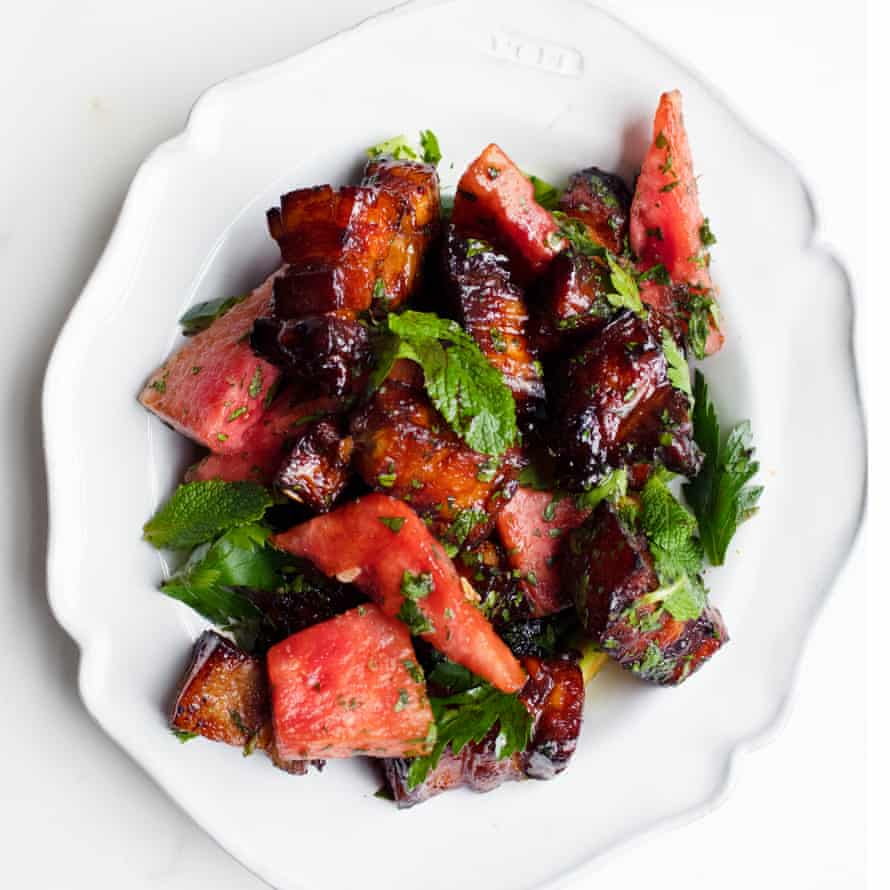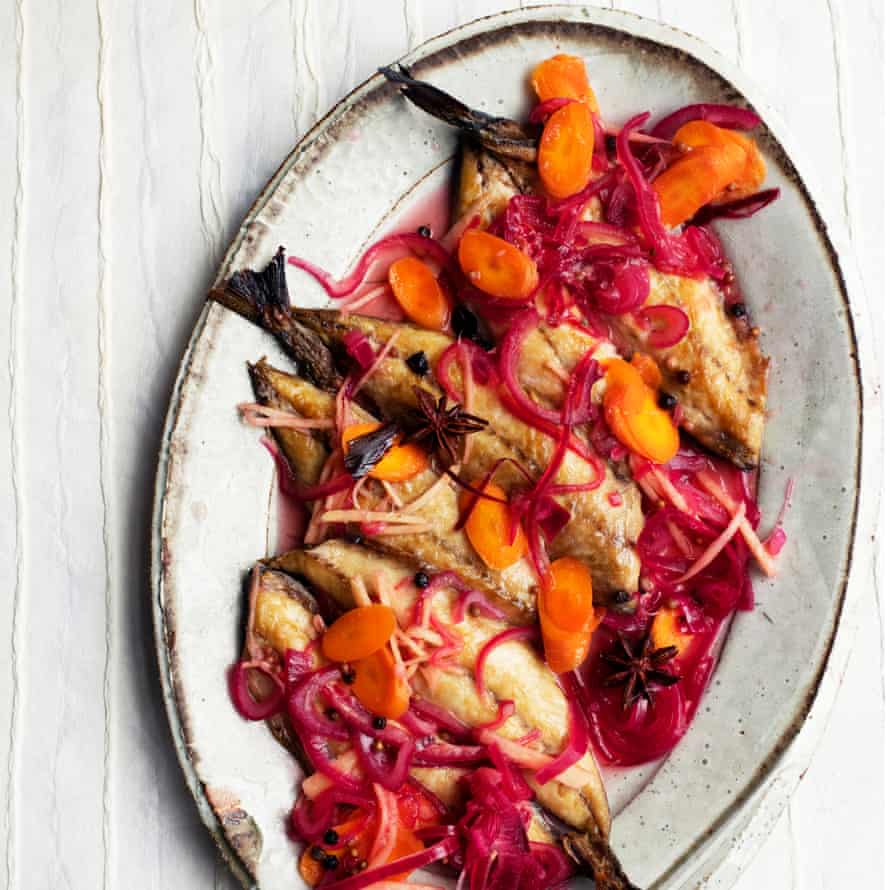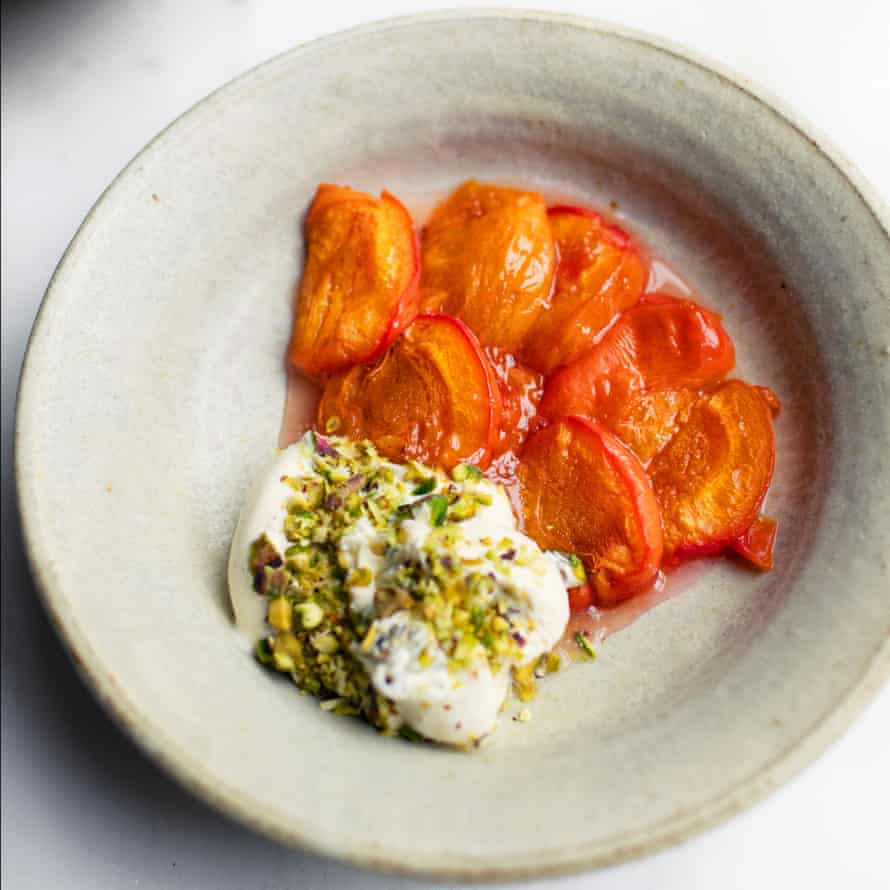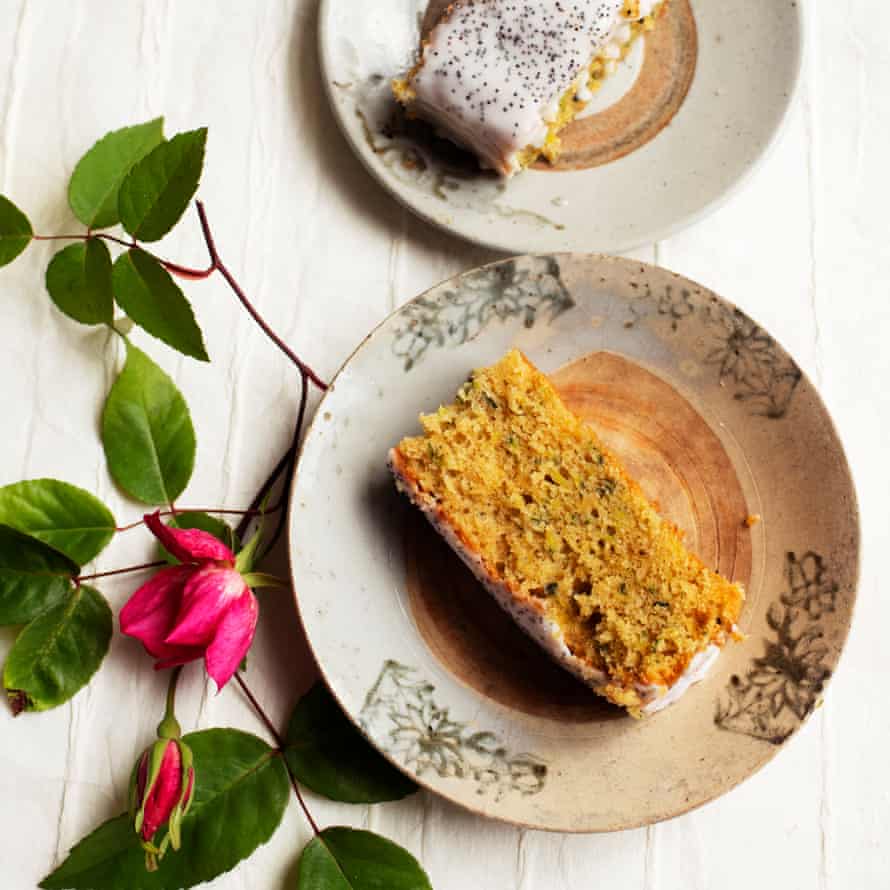A deep bowl of roast chicken salad with pea shoots and cherries; another of spiced pork with wedges of watermelon, ice-cold from the fridge. A platter of marinated mackerel for eating chilled with soft green leaves and a dessert of apricots baked with sugar and white wine. The summer kitchen, it seems, is here.
There is much to celebrate – bunches of white-tipped radishes in little bowls of ice; fat, butterhead lettuces to calm the spiciness of watercress or rocket. There are crisp cucumbers and plump bunches of mint for long summer drinks, and the first of the summer fruit is here too.
When I set out for the shops my first thought is always, “What is in season?” But there is more of a spring in my step now than at any other time of year. I could come home with little but fruit and vegetables in my bag, so rich are the offerings, but how good those vegetables are when eaten in the company of roast chicken or some grilled fish.
This month’s recipes have an ease about them. Nothing needs to be served the second it is ready, none of them is especially demanding of the cook’s time. These are recipes that fit comfortably with the long, easy days of summer ahead, days in which to celebrate the wealth of ingredients at our fingertips.
Roast chicken salad with lentils and cherries
The recipe suggests roasting the chicken from scratch, but you could equally use leftover chicken from the Sunday roast. Should you take that route, then keep the pieces of chicken as large and juicy as possible. I use thighs because the brown meat is so much tastier than the white breast meat, but use that if it is what you have.
Serves 4
chicken thighs 1kg, skin on
oil
small green lentils 125g
pea shoots 50g
cherries 350g
For the dressing
red wine vinegar 3 tbsp
dijon mustard ½ tsp
olive oil 5 tbsp
salt ½ tsp
parsley 2 tbsp, chopped
Set the oven at 180C fan/gas mark 6. Put the chicken thighs, not too tightly packed, into a roasting tin. Pour over a little oil, then season with salt and black pepper and roast for 35-40 minutes until crisp-skinned and cooked right through to the bone. Remove from the oven and set aside for 10 minutes.
In a medium-sized saucepan, cook the lentils in deep, lightly salted boiling water for about 25 minutes till firm but tender.
Make the dressing. In a small bowl, combine the red wine vinegar, mustard, olive oil, salt and several grinds of black pepper. Stir in the parsley and set aside. (I often put the ingredients in a tightly lidded jar and shake vigorously.)
Wash the pea shoots and leave them in a bowl of iced water for 25 minutes (they will emerge a little crisper than when they went in). Halve and stone the cherries and add them to the dressing. Drain the lentils in a colander, then add them to the cherries and dressing and stir gently to coat them lightly with the dressing.
Tear the chicken from the bone into generous, juicy pieces, large enough to require a knife and fork. Add the chicken to the cherries. Drain the pea shoots and dry them in a salad spinner or by shaking them in a colander. Combine with the chicken and serve.
Pork with watermelon and mint

A substantial salad – a wonderful contrast of cool and spicy, hot and cold. What really works for me here is the refreshing slices of chilled watermelon with the slightly spicy, molasses-like juices of the pork. I put the melon in the fridge overnight so the fruit is really cold when it meets the sticky, straight-from-the-oven pieces of pork.
Serves 4
pork belly 1kg, bone in, skin scored
light soy sauce 4 tbsp
rice vinegar 2 tbsp
fish sauce 2 tbsp
honey 3 tbsp
watermelon 500g
cucumber 200g
parsley sprigs 10g
mint sprigs 15g
Set the oven at 160C fan/gas mark 4. Put the kettle on to boil. Pour hot water from the kettle into a deep roasting tin, enough to come half-way up the side of the tin. Place a wire rack over the tin and lay the pork, its scored skin seasoned with sea salt, facing upwards. Cover the meat and wire rack loosely with kitchen foil, then carefully place in the preheated oven and leave for 2 hours. The pork will cook in its own steam.
In a small saucepan, mix together the soy sauce, rice vinegar, fish sauce and honey, and stir over a moderate heat for a couple of minutes until the honey has dissolved. Take the pork from the oven and remove the foil. Turn the oven up to 180C fan/gas mark 6.
Place the meat on a chopping board. Using a large knife, cut into approximately 3cm cubes, removing the bones as you go. Discard the water in the tin – it has done its work, though you could use it as a base for stock if you wish – then return the meat to the empty tin. Pour the soy mixture over the meat, stir well and return to the oven. Roast for 25-30 minutes, keeping a close eye on its progress. The sauce should be dark and bubbling, the meat glossy – but take care that it doesn’t burn.
While the pork roasts, remove the rind and seeds from the watermelon. Cut the flesh into large pieces, roughly the same size as the pork and put them in a bowl. Peel the cucumber and cut into slightly smaller pieces, then add to the melon. Remove the leaves from the parsley and mint, and finely chop and toss with the watermelon and cucumber.
Remove the pork from the oven, add to the salad, toss gently and transfer to a serving plate.
Marinated mackerel

The fish is filleted and grilled first, then marinated briefly in a piquant dressing, in the style of a classic escabeche. The onion adds piquancy – you could use shallots if you don’t have a red onion – and the star anise adds an aniseed note. I like a few slices of thin, dark rye bread with this, the sort that is treacle coloured and almost sticky to the touch.
Serves 3
white wine vinegar 75ml
lemon juice 120ml
carrot 1, small
red onion 1, small
garlic 1 clove
red chilli 1
star anise 2
coriander seeds 1 tsp
peppercorns 10
caster sugar 1 tsp
salt ½ tsp
mackerel 3, filleted
olive oil 3 tbsp
Pour the wine vinegar and lemon juice into a stainless-steel saucepan. Thinly slice the carrot. Peel and thinly slice the red onion, then add both to the pan. Peel and crush the garlic clove and finely chop the chilli, removing the seeds if you wish, then add both to the pan and bring to the boil over a moderate heat.
Add the star anise and coriander seeds, then the peppercorns. Stir in the sugar and half a teaspoon of salt. Once the onion has softened a little, remove from the pan from the heat.
Line a grill pan with foil then place the mackerel skin-side down on the foil. Brush lightly with a little of the olive oil then cook under a hot grill till lightly browned. Turn over and continue cooking till the skin is tinged golden and brown, then transfer to shallow dish. Pour the warm marinade over the fish, trickle with the rest of the olive oil, cover with clingfilm or a lid and set aside to cool, then chill for an hour or so in the fridge.
Serve the fillets with some of the marinating juices.
Apricots with pistachio creme fraiche

As the apricots bake with the sugar and wine, they become sweet and jammy, a perfect accompaniment for the tart and nutty creme fraiche. A crisp biscuit would be a lovely thing to offer with these, too, a plate of curly brandy snaps or crisp and sugary tuile.
Serves 4
apricots 12
caster sugar 2 tbsp
white wine 2 tbsp, or vermouth
For the pistachio creme fraiche
vanilla 1 pod
creme fraiche 200g
shelled pistachios 2 tbsp
Set the oven at 180C fan/gas mark 6. Cut the apricots in half and remove the stones. Place the fruit, cut side up, in a roasting dish. Sprinkle with caster sugar then trickle the wine or vermouth over the fruit, soaking the sugar.
Bake for about 20 minutes until the fruit is soft and tender, and the wine and sugar have formed a sticky sauce in the roasting tin.
Cut the vanilla pod in half lengthways. Using the point of a knife, scrape the vanilla seeds into a mixing bowl, then spoon in the creme fraiche. Finely chop the pistachios, then stir them gently into the creme fraiche and vanilla seeds.
Serve the apricots, hot and sticky from the roasting tin, with their syrup and a spoonful or two of the pistachio cream.
Courgette and lemon cake

The shreds of courgette lighten the cake and work particularly well with the lemon icing. This is a useful recipe for those who will, over the next few weeks, be besieged with gifts from their home-grown courgette plants.
Serves 12
eggs 3
self-raising flour 250g
baking powder 1 tsp
ground cinnamon 1 tsp
salt a pinch
sunflower oil 200ml
caster sugar 125g
light muscovado 125g
courgettes 400g
lemon finely grated zest of 1
For the icing
icing sugar 250g
lemon juice 5-6 tbsp
Set the oven at 160C fan/gas mark 4. Line a 20cm square cake tin with baking parchment.
Separate the eggs. Sift together the flour, baking powder, cinnamon and salt. Using a food mixer, whisk the oil and sugars together till thick, then whisk in the egg yolks, one at a time. Coarsely grate the courgettes, without peeling. Stir the courgette shreds into the sugar-egg mixture.
Stir the lemon zest and the flour-spice mixture into the cake mixture. In a clean bowl, whisk the egg whites till almost stiff, then fold tenderly into the mixture with a large metal spoon. Transfer to the lined cake tin, then bake for 30-35 minutes till lightly firm. Remove from the oven and leave to settle for 15 minutes.
Remove the cake from its tin and place on a cooling rack over a baking sheet. Make the icing by mixing the sugar and lemon juice until there are no lumps, then spoon over the surface of the cake, letting it run down the sides. Leave to set before cutting into 12 small rectangles.
The Guardian aims to publish recipes for sustainable fish. For ratings in your region, check: UK; Australia; US
The Link LonkJune 21, 2021 at 02:00PM
https://ift.tt/3qeLSEN
Pork and watermelon, chicken and cherries – Nigel Slater’s sweet and sour summer recipes - The Guardian
https://ift.tt/2RsHZwT
Pork

No comments:
Post a Comment